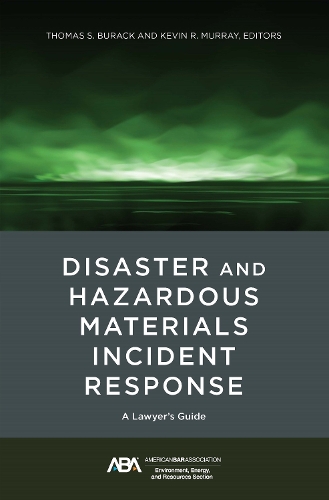
Disaster and Hazardous Materials Incident Response: A Lawyer's Guide
(Paperback)
Publishing Details
Disaster and Hazardous Materials Incident Response: A Lawyer's Guide
By (Author) Thomas Shakman Burack
Edited by Kevin R. Murray
American Bar Association
American Bar Association
3rd June 2026
United States
Classifications
Non Fiction
Environmental law
Physical Properties
Paperback
Width 152mm, Height 228mm
Description
Clients are facing disasters of all kinds and they quickly turn to their lawyers for answers and counsel. Disaster and Hazardous Materials Incident Response: A Lawyer's Guide follows an "all-hazards" approach and provides vital, practical guidance for private practitioners, in-house counsel, other attorneys and consultants helping organizations prepare for, respond to, and recover from disasters, including hazardous materials spills and releases. Early chapters provide an overview of disaster management and describe preparedness measures that organizations can implement to make themselves more resilient and thus better equipped to handle the next disaster or incident. A section on release reporting focuses on reporting to governmental authorities as one of the very first and ongoing components of a responsible party's response to hazardous materials incidents. A release reporting and response timeline identifies some key actions to be taken within the first 24 hours of such releases. The book also examines FEMA's response and recovery programs by detailing the federal disaster declaration process and a number of FEMA's most significant programs for assisting communities and individuals. As an example of governmental responses to environmental challenges, the book explores the National Contingency Plan as the principal set of regulations that guide responses to incidents involving releases of oil, hazardous substances, pollutants or contaminants. This chapter illustrates how one Emergency Support Function of disaster management fits and interacts within the larger, government-wide, National Response Framework and is implemented using the National Incident Management System.
Alongside the procedural discussions, the book includes an evaluation of responses to transportation-related hazardous materials incidents: trains, pipelines, ships, and trucks. The book examines the recovery phase with an in-depth analysis of liability and defenses arising in the context of spills or releases of hazardous substances. This chapter focuses on the Comprehensive Environmental Response, Compensation, and Liability Act and common law as examples of statutory principles and legal theories useful in analyzing liability or defenses associated with all types of releases or disasters.
A discussion of the multi-faceted role of insurance in environmental disasters and climate change, and basic guidance on preparing for a government agency investigation complete the book's coverage of the disaster recovery.
Author Bio
Thomas (Tom) Burack, Esq., is a shareholder at Sheehan Phinney Bass & Green PA, in Manchester, NH, where his diverse legal and consulting practice includes projects involving PFAS and other emerging contaminants in the contexts of contaminated sites, commercial transactions, and regulatory process improvement and policymaking. In Toms first 17 years at the firm (1989-2006), his work focused on brownfields redevelopment, Superfund defense, RCRA compliance, insurance coverage disputes involving contaminated sites, and a broad range of environmental, energy, and occupational safety and health matters. From 2006 through 2016, Tom served as Commissioner of the New Hampshire Department of Environmental Services, where he played a leading role in formulating and implementing the states approach to addressing PFAS contamination. Since returning to the firm in 2017, PFAS issues have continued to occupy his interest and attention. Tom is a Fellow in the American College of Environmental Lawyers and a graduate of the University of Virginia School of Law. Kevin R. Murray is known for his innovative and unique resolutions to complex contamination issues, especially involving multi-jurisdictional and multi-agency matters (particularly EPA and NRC) in the mining, real estate, energy, petroleum, nuclear, and manufacturing industries. His practice focuses on managing environmental liabilities, repurposing real estate assets, and creating value through property remediation and planning. Kevin is respected for his strategic approach to crafting cutting-edge legal solutions that deliver maximum value for his clients, ranging from the largest international corporations to individual landowners. He has been the lead attorney for billions of dollars of acquisitions and development of environmentally challenged assets worldwide, including many Superfund sites. Kevin has significant experience with CERCLA, RCRA, state hazardous waste laws, and related programs, and substantial experience with uranium mine and mill remediation and decommissioning. His work in the disaster arena comes in advising on planning for private development sustainability and resilience. Kevin is a former president of the American College of Environmental Lawyers and the editor of the fifth edition of Environmental Aspects of Real Estate and Commercial Transactions: Acquisition, Development, and Liability Management, published by the ABA. He is a member of the editorial board of the ABA SEER Natural Resources & Environment Journal, a member of the American Law Institute, and a member of the Environmental Law Institute where he serves on the Leadership Steering Committee of the Leadership Council.
